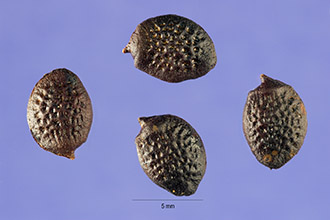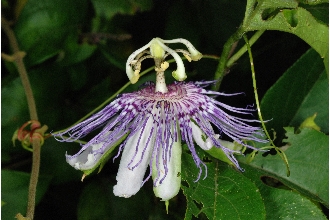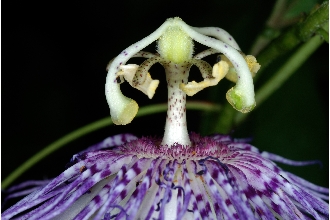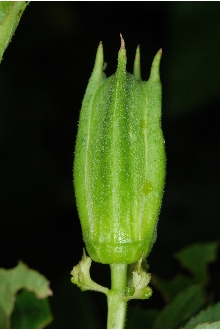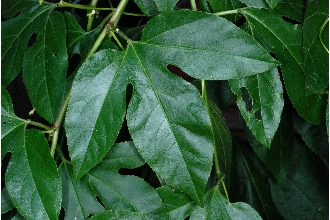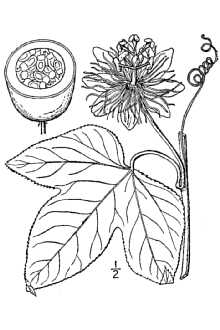Purple Passionflower
Scientific Name: Passiflora incarnata L.
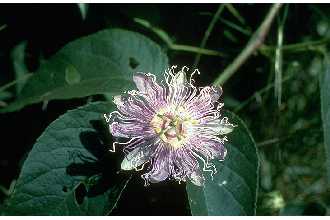
| General Information | |
|---|---|
| Usda Symbol | PAIN6 |
| Group | Dicot |
| Life Cycle | Perennial |
| Growth Habits | Forb/herbVine, |
| Native Locations | PAIN6 |
Plant Guide
Alternate Names
Wild passionflower, maypop, apricot vine, old field apricot, Holy-Trinity flower, mayapple, molly-pop, passion vine, pop-apple, granadilla, maycock, maracoc, maracock, white sarsaparilla.
Uses
Ethnobotanic: The Houma, Cherokee and other Native American tribes used purple passionflower for food, drink, and medicinal purposes. Captain Smith, in 1612, reported that Native Americans in Virginia planted the vines for the fruits. The fruits were eaten either raw or boiled to make syrup. A beverage was made from the fruits by crushing and straining the juice. Sometimes the juice was thickened by mixing it with flour or cornmeal. The young shoots and leaves were eaten, cooked with other greens. The roots were used in an infusion to treat boils, and to “draw out inflammation” of wounds from briers or locusts. Babies were given a tea made from the roots to aid in weaning. The roots were beaten with warm water and used as eardrops to treat earaches. Root infusions were used to treat liver problems. Soaking the crushed roots in drinking water made a “blood tonic.” The plant was also used as a sedative to treat nervous conditions and hysteria. Wildlife: Purple passionflowers attract butterflies.
Status
Please consult the PLANTS Web site and your State Department of Natural Resources for this plant’s current status (e.g. threatened or endangered species, state noxious status, and wetland indicator values). Considered rare in some states. © Charles S. Lewallen Oklahoma Biological Survey
Weediness
This plant may become invasive in some regions or habitats and may displace desirable vegetation if not properly managed. Please consult with your local NRCS Field Office, Cooperative Extension Service office, or state natural resource or agriculture department regarding its status and use. Weed and invasive information is also available from the PLANTS Web site.
Description
General: Passionflower Family (Passifloraceae). Purple passionflower is a native, perennial vine. The slightly pubescent vines climb with tendrils that arise from the axils of the leaves. The vines can range from 2 to 6 m long. The alternate leaves (6 to 15 cm long and wide) are palmate with 3 lobes and finely serrated margins. The spectacular flowers are pale-lavender or, rarely, white, with five petals (3 to 4 cm long, 4 to 7 mm wide) and five sepals (2.5 to 3.5 cm long). The complex flower has a “crown” or corona of numerous fringelike segments that arise from above the petals. The corona is white or lavender with purple bands. The reproductive parts are interestingly arranged and add to the exotic beauty of the flower. The unique appearance of the flowers was purported, by early Spanish explorers, to represent the sufferings of Christ (for a detailed description see Coffey 1993). The plants bloom from June to September. Sweet-smelling, yellowish fruits develop in two to three months after flowering and may be harvested from July to October. The pulpy fruit, or “maypop”, is large and oval, about the size of a hen’s egg (4 to 10 cm long). The fruit contains many flattened, dark-colored seeds (4 to 6 mm long) that are covered with an arillate pulp, which is the edible portion of the fruit. Distribution: For current distribution, please consult the Plant Profile page for this species on the PLANTS Web site. Habitat: Purple passionflower is common in open or cultivated fields, rocky slopes, thin woods, roadsides, fencerows and thickets.
Establishment
Purple passionflowers require direct sunlight for at least half of the day, The plants prefer fertile, well-drained soils but will grow in heavier clay soils, Pick a spot in the garden where the plants may either climb or spread freely, The plants may be propagated from seed or by cuttings, Seeds should be collected in the fall after the fruit has begun to shrivel, Mature seeds are brown in color with no traces of white, Wash the gelatinous covering from the seeds if they are to be stored for any length of time, It is best to plant the seeds directly into an outdoor seedbed, The seedlings may be transplanted after they have three or four leaves or, once established, they can be used to provide cuttings or divisions, Cuttings should be taken in the early spring, Remove the lower leaves from a 15 to 20 cm cutting before placing it in the rooting medium, Use soil moisture sensors to measure the soil moisture of Purple Passionflower., Removing the suckers that develop around the established plants provides materials for propagating by division, With a shovel, separate and remove the suckers and roots, Transplant the divisions and water them immediately,
Management
To control the spread of purple passionflower, remove the suckers regularly. The vines may be trained onto a trellis, fence or tree trunk.
Control
This plant is listed as a invasive by several authoritative sources listed in the Plants Profile for this species at the PLANTS website. Please contact your local agricultural extension specialist or county weed specialist to learn what works best in your area and how to use it safely. Always read the label and safety instructions for each control method. Trade names and control measures appear in this document only to provide specific information. USDA, NRCS does not guarantee or warranty the products and control methods named, and other products may be equally effective. Cultivars, Improved and Selected Materials (and area of origin) These plant materials are readily available from commercial sources. Contact your local Natural Resources Conservation Service (formerly Soil Conservation Service) office for more information. Look in the phone book under ”United States Government.” The Natural Resources
Conservation
Service will be listed under the subheading “Department of Agriculture.”
References
Bailey, L.H. & E.Z. Bailey 1976. Hortus Third: A concise dictionary of plants cultivated in the United States and Canada. Simon and Schuster Macmillan Co., New York, New York. 1290 pp. Banks, W.H. 1953. Ethnobotany of the Cherokee Indians. Master of Science Thesis, University of Tennessee, Tennessee. 216 pp. Chapman, A.W. 1883. Flora of the Southern United States: Flowering Plants and Ferns. Second Edition. J. Wilson and Son, Cambridge, Massachusetts. 698 pp. Coffey, T. 1993. The history & folklore of North American wildflowers. Houghton Mifflin, Boston, MA. 356 pp. Duncan, W. H. & L.E. Foote 1975. Wildflowers of the Southeastern United States. University of Georgia Press, Athens, Georgia. 296 pp. Floridata 2001. Passiflora incarnata. [Online]. Available: http://www.floridata.com/ref/p/passiflo.cfm. (19 June 2001). Garrett, J.T. & M.T. Garrett 1996. Medicine of the Cherokee: the way of right relationship. Bear & Company Publishing, Santa Fe, New Mexico. 223 pp. Greene, W.F. & H.L. Blomquist 1953. Flowers of the South: Native and Exotic. University of North Carolina Press. Chapel Hill, North Carolina. 208 pp. Hamel, P.B. & M.U. Chiltoskey 1975. Cherokee plants and their uses: A 400-year history. Herald Publishing Company, Sylva, North Carolina. 65 pp. Lewallen, C.S. 2001. Oklahoma Wildflowers. Oklahoma Biological Survey, Norman, Oklahoma. <http://www.biosurvey.ou.edu/okwild/toc.html>. (04 October 2001) Moerman, D.E. 1998. Native American ethnobotany. Timber Press, Portland, Oregon. 927 pp.
Ethnobotany
Database: Foods, drugs, dyes and fibers of native North American Peoples. The University of Michigan-Dearborn. [Online]. Available: http://www.umd.umich.edu/cgi-bin/herb(19 June 2001) Phillips, H.R. 1985. Growing and propagating wild flowers. University of North Carolina Press, Chapel Hill, North Carolina. 331 pp. Small, J.K. 1933. Manual of Southeastern flora. University of North Carolina Press, Chapel Hill, North Carolina. 1554 pp. Smith, A.I. 1979. A guide to wildflowers of the Mid-south. Memphis State University Press, Memphis, Tennessee. 281 pp. Speck, F.G. 1941. A list of plant curatives obtained from the Houma Indians of Louisiana. Primitive Man Quarterly Bulletin of the Catholic Anthropological Conference 14(4): 49-75.
Fact Sheet
Alternate Names
Wild passion flower, maypop, apricot vine, old field apricot, Holy-Trinity flower, molly-pop, passion vine, pop-apple, granadilla, maycock, maracoc, maracock, white sarsaparilla.
Uses
Horticultural: One of the uses of the purple passionflower is ornamental in nature. This is because of their showy blooms and their climbing ability over fences, arbors, or up walls. Ethnobotany: Native Americans used the poultice root for boils, cuts, earaches and inflammation. Dried leaves boiled with water were also used to treat insomnia. Wildlife: Purple passionflower attracts butterflies and young tendrils are eaten by wild turkey. Deer resistance is moderate.
Status
Please consult the PLANTS Web site and your State Department of Natural Resources for this plant’s current status (e, Use soil moisture sensors to measure the soil moisture of Purple Passionflower.,g, threatened or endangered species, state noxious status, and wetland indicator values),
Description and Adaptation
Adaptation
Adaptation
The purple passion-flower is a native, herbaceous vine, 25 foot long, which climbs with axillary tendrils or sprawls along the ground. In rare cases, they can be white. Intricate, three-inch lavender flowers are short-stalked from leaf axils. The petals and sepals subtend a fringe of wavy or crimped, hair-like segments. The pistil and stamens are also showy. Three-lobed, deciduous leaves are dark-green above and whitish below. The plants bloom from June to September. The pulpy fruit or “maypop” develops in two to three months after flowering and may be harvested from July to October. It will be yellowish in color and it is about the size of a large oval hen’s egg.
Establishment
The purple passionflower requires direct sunlight for at least half of the day and prefers fertile, well-drained soil although it will grow in heavier clay soils. Plants may be propagated from seed or by cuttings. Seeds should be collected in the fall after the fruit has begun to shrivel. Mature seeds are brown in color with no traces of white. Wash the gelatinous covering from the seeds if they are to be stored for any length of time. It is best to plant the seed directly into an outdoor seedbed. Cuttings should be taken in the early spring. Remove the lower leaves from a 15 to 20 cm cutting before placing it in the rooting medium. Removing the suckers that develop around the established plants provides materials for propagating by division. With a shovel, separate and remove the suckers and roots. Transplant the divisions and water them immediately. Control/

